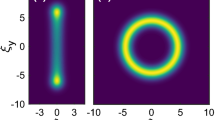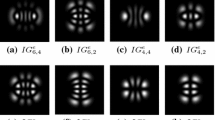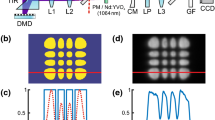Abstract
The Fox-Smith mirror (FSM) has long been used in a three-mirror laser cavity arrangement for forcing the laser oscillation on a single-longitudinal mode. However, its transverse properties are very little studied, and we report three interesting transverse features. First, the FSM gives the possibility to change the order p of the oscillating radial Laguerre–Gaussian LGp0 mode by adjusting the microscopic position of one of its mirrors. These results help for understanding non-interpreted experimental observations of interferometric control of the oscillating transverse mode reported by Smith in 1965. Second, we have shown that otherwise values of FSM parameters allow an equal FSM reflectivity of LG00 and LG01 (doughnut) modes. This would in effect give, to a laser using a FSM as rear mirror, a simultaneous oscillation of these two transverse modes giving rise to a shape-invariant flat-top laser beam. The latter having the interesting property to keep its uniform transverse intensity profile as it propagates inside and outside the laser cavity. Third, we have shown that the beam emerging from the FSM output through its beam splitter can be an Optical Bottle Beam by an adequate choice of parameters.











Similar content being viewed by others
References
T. Li, Diffraction loss and selection of modes in maser resonator with circular mirrors. Bell. Syst. Tech. J. 44, 917–932 (1965)
S. Ngcobo, K. Aït-Ameur, N. Passilly, A. Hasnaoui, A. Forbes, Exciting higher-order radial Laguerre-Gaussian modes in a diode-pumped solid state laser resonator. Appl. Opt. 52, 2090–2101 (2013)
A.A. Ishaaya, N. Davidson, G. Machavariani, E. Hasman, A.A. Friesem, Efficient selection of high-order Laguerre-Gaussian modes in a Q-switched Nd:YAG Laser. IEEE J. Quant. Electron. 39, 74–82 (2003)
Y. Senatsky, J.-F. Bisson, J. Li, A. Shirakawa, M. Thirugnanasambandam, K.-I. Ueda, Laguerre-Gaussian Modes Selection in diode-pumped solid-state lasers. Opt. Rev. 19, 201–221 (2012)
P.W. Smith, Single-frequency lasers in Lasers: a Series of Advances, Vol. 4, ed. by A.K. Levine, A.J. DeMaria (Dekker, New York), Chap. 2 (1976)
P.W. Smith, Mode selection in lasers. Proc. IEEE 60, 422–440 (1972)
L. Grossard, A. Desfarges-Berthelemot, B. Colombeau, V. Couderc, C. Froehly, Dual frequency tunable CW Nd:YAG laser. Opt. Commun. 188, 353–357 (2001)
E. Nichelatti, G. Salvetti, Transverse modes in laser cavities terminating in reflective multipass interferometers. Appl. Opt. 34, 2655–2658 (1995)
Y. Wang, Y. Qu, W. Zhao, D. Ren, X. Hu, Single longitudinal mode pulse from a TEA CO2 laser by using a three-mirror resonator with a Fabry-Pérot etalon. Appl. Phys. B 92, 237–241 (2008)
X. Huang, L. Huang, M. Gong, Q-switched operation with Fox-Smith-Michelson laser cavity. Laser Phys. Lett. 5, 189–192 (2008)
S. Vlasov, E. Koposova, Theory of coupled open resonators. Phys. Wave Phenomena 18, 7–13 (2010)
P.W. Smith, Stabilized single-frequency output from a long laser cavity. IEEE J. Quant. Electron. QE-1, 343–348 (1965)
M. Tobar, T. Suzuki, K. Kuroda, Detecting free-mass common-mode motion induced by incident gravitational waves. Phys. Rev. D 59, 102002 (1999)
A. Agnesi, V. Degiorgio, Beam splitter phase shifts: wave optics approach. Opt. Las. Tech. 95, 72–73 (2017)
M. Born, E. Wolf, Principle of optics sixth (corrected) Ed Pergamon Press (Oxford-New York-Seoul-Tokyo) (1980)
H. Abu-Safia, R. Al-Tahtamouni, I. Abu-Aljarayesh, N. Yusuf, Transmission of a Gaussian beam through a Fabry-Pérot interferometer. Appl. Opt. 33, 3805–3811 (1994)
K. Aït-Ameur, Reflection and transmission of the first two Laguerre-Gauss modes incident on a Fabry-Perot interferometer. J. Mod. Opt. 43, 99–104 (1996)
K. Aït-Ameur, Transverse properties of a Michelson mirror. Appl. Opt. 36, 1860–1866 (1997)
D. Naidoo, K. Aït-Ameur, I. Litvin, M. Fromager, A. Forbes, Observing mode propagation inside a laser cavity. N. J. Phys. 14, 053021 (2012)
J.W. Kim, W.A. Clarkson, Selective generation of Laguerre-Gaussian (LG0n) mode output in a diode-laser pumped Nd:YAG laser. Opt. Commun. 296, 109–112 (2013)
D.J. Kim, J.W. Kim, Dual-cavity Nd:YAG laser with Laguerre-Gaussian (LG0n) mode output. Opt. Commun. 383, 26–30 (2017)
E. Cagniot, M. Fromager, T. Godin, N. Passilly, K. Aït-Ameur, Transverse super-resolution technique involving rectified Laguerre Gaussian LGp0 beam. J. Opt. Soc. Am. A 28, 1709–1715 (2011)
S. Haddadi, O. Bouzid, M. Fromager, A. Hasnaoui, A. Harfouche, E. Cagniot, A. Forbes, K. Aït-Ameur, Structured Laguerre-Gaussian beams for mitigation of spherical aberration in tightly focused regimes. J. Opt. 20, 045602 (2018)
A. Bencheikh, M. Fromager, K. Ait-Ameur, Extended focus depth for Gaussian beam using binary phase diffractive optical elements. Appl. Opt. 57, 1899–1903 (2018)
A. Ashkin, Trapping of atoms by resonance radiation pressure. Phys. Rev. Lett. 40, 729–732 (1978)
J. Chaloupka, D. Meyerhofer, Characterization of a tunable, single-beam ponderative-optical trap. J. Opt. Soc. Am. B 17, 713–722 (2000)
R. Bourouis, K. Aït-Ameur, H. Ladjouze, Optimization of the Gaussian beam flattening using a phase-plate. J. Mod. Opt. 44, 1417–1427 (1997)
O. Magnin, P. Meyrueis, Diffractive beam shaper for blood cells optical characterization. Opt. Commun. 217, 1–6 (2003)
R. El-Agmy, H. Bulte, A. Greenaway, D. Reid, Adaptive beam profile control using a simulated annealing algorithm. Opt. Express 13, 6085–6091 (2005)
S. Avino, E. Calloni, L. Milano, L. DiFiore, R. De. Rosa, A. Tierno, Generation of non-Gaussian flat laser beams. Phys. Lett. A 355, 258–261 (2006)
A. Harfouche, B. Boubaha, M. Fromager, K. Aït-Ameur, Comparison between interferometric and diffractive laser beam shaping. J. Opt. 16, 125712 (2014)
I. Litvin, A. Forbes, Intra-cavity flat-top beam generation. Opt. Express 17, 15891–15903 (2009)
S. Tao, X. Yuan, Mode shaping at a given distance outside a resonator with diffractive optical elements. J. Opt. A: Pure Appl. Opt. 5, 511–514 (2003)
S. Scoles, H. Spoor, K. Aït-Ameur, Q. Zhan, A. Forbes, General design principle for structured light lasers. Opt. Express 28, 35006 (2020)
S. Ngcobo, K. Aït-Ameur, I. Litvin, A. Hasnaoui, A. Forbes, Tuneable Gaussian to flat-top resonator by amplitude beam shaping. Opt. Express 21, 21113–21118 (2013)
O. Bouzid, A. Hasnaoui, K. Aït-Ameur, Simple intra-cavity beam shaping for generating a shape-invariant flat-top laser beam. Optik 201, 163494 (2020)
D. Naidoo, A. Harfouche, M. Fromager, K. Aït-Ameur, A. Forbes, Emission of a propagation invariant flat-top beam from a microchip laser. J. Lumin. 170, 750–754 (2016)
B. Boubaha, D. Naidoo, T. Godin, M. Fromager, A. Forbes, K. Aït-Ameur, Spatial properties of coaxial superposition of two coherent Gaussian beams. Appl. Opt. 52, 5766–5772 (2013)
H. Rubinsztein-Dunlop, T.A. Nieminen, M.E.J. Friese, N.R. Heckenberg, Optical trapping of absorbing particles. Adv. Quant. Chem. 30, 469–492 (1998)
K. Dholakia, P. Reece, M. Gu, Optical micromanipulation. Chem. Soc. Rev. 37, 42–55 (2008)
P. Xu, X. He, J. Wang, M. Zhan, Trapping a single atom in a blue detuned optical bottle beam trap. Opt. Lett. 35, 2164–2166 (2010)
O. Bouzid, S. Haddadi, M. Fromager, E. Cagniot, K. Ferria, A. Forbes, K. Aït-Ameur, Focusing anomalies with binary diffractive optical elements. Appl. Opt. 56, 9735–9741 (2017)
Author information
Authors and Affiliations
Corresponding author
Ethics declarations
Conflicts of interest
The authors declare no conflicts of interest.
Additional information
Publisher's Note
Springer Nature remains neutral with regard to jurisdictional claims in published maps and institutional affiliations.
Appendix: Reflectivity and transmission of the Fox-Smith mirror for plane waves
Appendix: Reflectivity and transmission of the Fox-Smith mirror for plane waves
We will present in this Appendix an elegant method for calculating the reflectivity \(R_{{{\text{FS}}}}\) and the transmission \(T_{{{\text{FS}}}}\) of the Fox-Smith mirror which can be called as round-trip method. The latter does not need to sum up all the different reflected waves so forming a geometric series such as in Fabry–Pérot interferometer calculations [13, 15]. The Fox-Smith mirror shown in Figs.
12 and
Fox-Smith mirror showing the incident field \(E^{{\text{I}}}\), the transmitted field \(E^{{\text{T}}}\), the internal field E(t) given by Eq. (14)
13 has one input port (field \(E^{{\text{I}}}\)) and two output ports (fields \(E^{{\text{R}}}\) and \(E^{{\text{T}}}\)).
Let us consider a plane wave characterised by the electric field \(E^{{\text{I}}}\) incident on the Fox-Smith mirror, and let \(E^{{\text{R}}}\) the electrical field associated with the reflected waves (Fig. 12).
The beam splitter (BS) split the input plane wave into a proportion (in intensity) K in the reflection and (1−K) in its transmission, respectively. Consequently, the reflectance r and the transmittance \(\tau\) (ratio of amplitudes) of the beam splitter are given by \(r = \sqrt K\) and \(\tau = \sqrt {1 - K}\). Taking into account the phase shift (Fig. 2) introduced by the beam splitter we can write that the field E(t + Δt) after a round-trip inside the FS mirror as follows:
where \(\varphi = 2k(d_{1} + d_{2} )\) and \(\Delta t = 2(d_{1} + d_{2} )/c\).
Equation (13) involves the dynamic of the electrical field over a round-trip inside the Fox-Smith mirror. The steady-state is defined by \(E(t + \Delta t) = E(t)\), and allows to express the field E(t) as follows:
1.1 Reflectivity of the Fox-Smith mirror
The reflected field \(E^{{\text{R}}}\) corresponds to the field E having made a round-trip between the beam splitter and mirror M1, transmitted through BS, namely:
By combining Eqs. 14 and 15 we obtain the reflectance \(r_{{{\text{FS}}}}\) of the Fox-Smith mirror:
Finally, the reflectivity \(R_{{{\text{FS}}}} = r_{{{\text{FS}}}} \times r_{{{\text{FS}}}}^{*}\) of the Fox-Smith mirror enlighten by plane waves is written as follows
Finally by setting \(F = 4K/(1 - K)^{2}\) we obtain
1.2 Transmission of the Fox-Smith mirror
Figure 13 shows the different quantity for calculating the transmitted field \(E^{T}\) for reference purpose. The field \(E_{1}\) shown in Fig. 13 corresponds to the field E having travelled the distance \((2d_{1} + 2d_{2} )\) and undergoing a reflection on the beam splitter.
As a consequence, one can write:
Then the transmitted field \(E^{{\text{T}}}\) can be expressed as follows:
Finally from the transmittance \(t_{{{\text{FS}}}} = E^{{\text{T}}} /E^{{\text{I}}}\), we express the transmission \(T_{{{\text{FS}}}} = t_{{{\text{FS}}}} \times t_{{{\text{FS}}}}^{*}\) (ratio of intensities):
Since \(\left( {r^{2} + \tau^{2} } \right) = 1\), then we obtain:
By adding \(\left( {2r^{2} - 2r^{2} } \right)\) to the denominator of Eq. (20), and taking into account the definition of parameter F, we finally obtain:
Note that we find obviously \(\left( {R_{{{\text{FS}}}} + T_{{{\text{FS}}}} } \right) = 1\).
Rights and permissions
About this article
Cite this article
Habchi, A., Harfouche, A. & Aït-Ameur, K. Flexible control of laser transverse modes using a Fox-Smith mirror . Appl. Phys. B 127, 97 (2021). https://doi.org/10.1007/s00340-021-07643-4
Received:
Accepted:
Published:
DOI: https://doi.org/10.1007/s00340-021-07643-4






